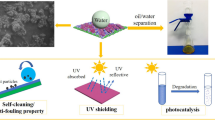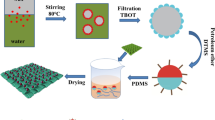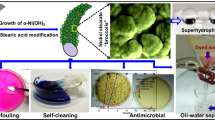Abstract
Surfaces with robust and healable superhydrophobicity have attracted much attention in recent years due to an improved life-time. Herein, flower-like nickel hydroxide (Ni(OH)2) micro-nanoparticles are prepared and used as reservoirs to load octadecylamine (ODA). Superhydrophobic cotton fabric is fabricated by dip-coating ODA modified Ni(OH)2 particles (Ni(OH)2@ODA) using polydimethylsiloxane (PDMS) as hydrophobic binder. The influence of Ni(OH)2@ODA content on the surface morphology and wettability of the fabric is systematically investigated. The modification processes do not cause any discernable decrease in the mechanical and thermal properties of the fabric. The fabric exhibits excellent antifouling and self-cleaning performances, and can maintain superhydrophobicity after 700 abrasion cycles, strong acidic or alkaline corrosion and long-term UV exposure. It can effectively separate different oil–sea water mixtures with high separation efficiency, high flux and good reusability. Significantly, the superhydrophobicity of a damaged fabric surface from O2 plasma treatment can be automatically restored within 6 h at room temperature and 60 min at 50 °C. This facile and effective strategy may be useful for the development of robust protective clothing for various applications.
Graphic abstract










Similar content being viewed by others
References
Cao C, Ge M, Huang J, Li S, Deng S, Zhang S, Chen Z, Zhang K, Al-Deyab SS, Lai Y (2016) Robust fluorine-free superhydrophobic PDMS–ormosil@fabrics for highly effective self-cleaning and efficient oil–water separation. J Mater Chem A 4:12179–12187
Chang YH, Hau NY, Liu C, Huang YT, Li CC, Shih K, Feng SP (2014) A short-range ordered–disordered transition of a NiOOH/Ni(OH)2 pair induces switchable wettability. Nanoscale 6:15309–15315
Chauhan P, Kumar A, Bhushan B (2019) Self-cleaning, stain-resistant and anti-bacterial superhydrophobic cotton fabric prepared by simple immersion technique. J Colloid Interface Sci 535:66–74
Chen XC, Ren KF, Zhang JH, Li DD, Zhao E, Zhao ZJ, Xu ZK, Ji J (2015) Humidity-triggered self-healing of microporous polyelectrolyte multilayer coatings for hydrophobic drug delivery. Adv Funct Mater 25:7470–7477
Chen K, Gou W, Xu L, Zhao Y (2018) Low cost and facile preparation of robust multifunctional coatings with self-healing superhydrophobicity and high conductivity. Compos Sci Technol 156:177–185
Chen J, Zhou Y, Zhou C, Wen X, Xu S, Cheng J, Pi P (2019) A durable underwater superoleophobic and underoil superhydrophobic fabric for versatile oil/water separation. Chem Eng J 370:1218–1227
Cheng QY, An XP, Li YD, Huang CL, Zeng JB (2017) Sustainable and biodegradable superhydrophobic coating from epoxidized soybean oil and ZnO nanoparticles on cellulosic substrates for efficient oil/water separation. ACS Sustain Chem Eng 5:11440–11450
Cheng QY, Guan CS, Wang M, Li YD, Zeng JB (2018) Cellulose nanocrystal coated cotton fabric with superhydrophobicity for efficient oil/water separation. Carbohydr Polym 199:390–396
Deng B, Cai R, Yu Y, Jiang H, Wang C, Li J, Li L, Yu M, Li J, Xie L, Huang Q, Fan C (2010) Laundering durability of superhydrophobic cotton fabric. Adv Mater 22:5473–5477
Fan B, Wei G, Zhang Z, Qiao N (2014) Characterization of a supramolecular complex based on octadecylamine and β-cyclodextrin and its corrosion inhibition properties in condensate water. Corros Sci 83:75–85
Gao L, He J (2013) Surface hydrophobic co-modification of hollow silica nanoparticles toward large-area transparent superhydrophobic coatings. J Colloid Interface Sci 396:152–159
Gao A, Wu Q, Wang D, Ha Y, Chen Z, Yang P (2016) A superhydrophobic surface templated by protein self-assembly and emerging application toward protein crystallization. Adv Mater 28:579–587
Guo F, Wen Q, Peng Y, Guo Z (2017a) Multifunctional hollow superhydrophobic SiO2 microspheres with robust and self-cleaning and separation of oil/water emulsions properties. J Colloid Interface Sci 494:54–63
Guo F, Wen Q, Peng Y, Guo Z (2017b) Simple one-pot approach toward robust and boiling-water resistant superhydrophobic cotton fabric and the application in oil/water separation. J Mater Chem A 5:21866–21874
Hou K, Zeng Y, Zhou C, Chen J, Wen X, Xu S, Cheng J, Pi P (2018) Facile generation of robust POSS-based superhydrophobic fabrics via thiol-ene click chemistry. Chem Eng J 332:150–159
Huang Z, Gurney RS, Wang Y, Han W, Wang T, Liu D (2019) TDI/TiO2 hybrid networks for superhydrophobic coatings with superior UV durability and cation adsorption functionality. ACS Appl Mater Interfaces 11:7488–7497
Kang H, Liu Y, Lai H, Yu X, Cheng Z, Jiang L (2018) Under-oil switchable superhydrophobicity to superhydrophilicity transition on TiO2 nanotube arrays. ACS Nano 12:1074–1082
Kim SM, Jeon H, Shin SH, Park SA, Jegal J, Hwang SY, Oh DX, Park J (2018) Superior toughness and fast self-healing at room temperature engineered by transparent elastomers. Adv Mater 30:1705145
Lee JH, Kim DH, Han SW, Kim BR, Park EJ, Jeong MG, Kim JH, Kim YD (2016) Fabrication of superhydrophobic fibre and its application to selective oil spill removal. Chem Eng J 289:1–6
Li D, Guo Z (2017) Stable and self-healing superhydrophobic MnO2@fabrics: applications in self-cleaning, oil/water separation and wear resistance. J Colloid Interface Sci 503:124–130
Li Y, Chen S, Wu M, Sun J (2014) All spraying processes for the fabrication of robust, self-healing, superhydrophobic coatings. Adv Mater 26:3344–3348
Liu Q, Wang X, Yu B, Zhou F, Xue Q (2012) Self-healing surface hydrophobicity by consecutive release of hydrophobic molecules from mesoporous silica. Langmuir 28:5845–5849
Liu Y, Wang X, Fei B, Hu H, Lai C, Xin JH (2015) Bioinspired, stimuli-responsive, multifunctional superhydrophobic surface with directional wetting, adhesion, and transport of water. Adv Funct Mater 25:5047–5056
Liu M, Hou Y, Li J, Tie L, Peng Y, Guo Z (2017) Inorganic adhesives for robust, self-healing, superhydrophobic surfaces. J Mater Chem A 5:19297–19305
Liu SQ, Wen HR, Ying G, Zhu YW, Fu X-Z, Sun R, Wong CP (2018) Amorphous Ni(OH)2 encounter with crystalline CuS in hollow spheres: a mesoporous nano-shelled heterostructure for hydrogen evolution electrocatalysis. Nano Energy 44:7–14
Ma Q, Cheng H, Yu Y, Huang Y, Lu Q, Han S, Chen J, Wang R, Fane AG, Zhang H (2017) Preparation of superhydrophilic and underwater superoleophobic nanofiber-based meshes from waste glass for multifunctional oil/water separation. Small 13:1700391
Mai Z, Xiong Z, Shu X, Liu X, Zhang H, Yin X, Zhou Y, Liu M, Zhang M, Xu W, Chen D (2018) Multifunctionalization of cotton fabrics with polyvinylsilsesquioxane/ZnO composite coatings. Carbohydr Polym 199:516–525
Mai Z, Shu X, Li G, Chen D, Liu M, Xu W, Zhang H (2019) One-step fabrication of flexible, durable and fluorine-free superhydrophobic cotton fabrics for efficient oil/water separation. Cellulose 26:6349–6363
Qian H, Xu D, Du C, Zhang D, Li X, Huang L, Deng L, Tu Y, Mol JMC, Terryn HA (2017) Dual-action smart coatings with a self-healing superhydrophobic surface and anti-corrosion properties. J Mater Chem A 5:2355–2364
Qing Y, Yang C, Yu N, Shang Y, Sun Y, Wang L, Liu C (2016) Superhydrophobic TiO 2/polyvinylidene fluoride composite surface with reversible wettability switching and corrosion resistance. Chem Eng J 290:37–44
Shylesh S, Schünemann V, Thiel WR (2010) Magnetisch abtrennbare nanokatalysatoren: Brücken zwischen homogener und heterogener Katalyse. Angew Chem Int Edit 122:3504–3537
Si Y, Yang F, Guo Z (2017) Bio-inspired one-pot route to prepare robust and repairable micro-nanoscale superhydrophobic coatings. J Colloid Interface Sci 498:182–193
Song D, Zhu J, Xuan L, Zhao C, Xie L, Chen L (2018) Freestanding two-dimensional Ni(OH)2 thin sheets assembled by 3D nanoflake array as basic building units for supercapacitor electrode materials. J Colloid Interface Sci 509:163–170
Su X, Li H, Lai X, Zhang L, Liao X, Wang J, Chen Z, He J, Zeng X (2018) Dual-functional superhydrophobic textiles with asymmetric roll-down/pinned states for water droplet transportation and oil–water separation. ACS Appl Mater Interfaces 10:4213–4221
Tie L, Li J, Liu M, Guo Z, Liang Y, Liu W (2018) Facile fabrication of superhydrophobic and underwater superoleophobic coatings. ACS Appl Nano Mater 1:4894–4899
Wang J, Wang H (2019) Integrated device based on cauliflower-like nickel hydroxide particles–coated fabrics with inverse wettability for highly efficient oil/hot alkaline water separation. J Colloid Interface Sci 534:228–238
Wang M, Zhang Z, Wang Y, Zhao X, Yang M, Men X (2020) Superwetting fabrics towards multifunctional applications: oil/water separation, anti-fouling and flame-retardance. Appl Surf Sci 508:145265
Xue CH, Zhang ZD, Zhang J, Jia ST (2014) Lasting and self-healing superhydrophobic surfaces by coating of polystyrene/SiO2 nanoparticles and polydimethylsiloxane. J Mater Chem A 2:15001–15007
Xue CH, Bai X, Jia ST (2016) Robust, self-healing superhydrophobic fabrics prepared by one-step coating of PDMS and octadecylamine. Sci Rep 6:27262
Yang M, Liu W, Jiang C, Xie Y, Shi H, Zhang F (2019a) Facile fabrication of robust fluorine-free superhydrophobic cellulosic fabric for self-cleaning, photocatalysis and UV shielding. Cellulose 26:8153–8164
Yang Y, Huang W, Guo Z, Zhang S, Wu F, Huang J, Yang H, Zhou Y, Xu W, Gu S (2019b) Robust fluorine-free colorful superhydrophobic PDMS/NH2-MIL-125(Ti)@cotton fabrics for improved ultraviolet resistance and efficient oil–water separation. Cellulose 26:9335–9348
Yoo Y, You JB, Choi W, Im SG (2013) A stacked polymer film for robust superhydrophobic fabrics. Polym Chem 4:1664–1671
Zhang W, Liu N, Cao Y, Chen Y, Xu L, Lin X, Feng L (2015) A solvothermal route decorated on different substrates: controllable separation of an oil/water mixture to a stabilized nanoscale emulsion. Adv Mater 27:7349–7355
Zhang Y, Yu L, Hu R, Zhang J, Wang Y, Niu R, Qian X, Zhu J (2018) Biomass-derived C/N co-doped Ni(OH)2/NixSy with a sandwich structure for supercapacitors. J Mater Chem A 6:17417–17425
Zhang YR, Chen JT, Hao B, Wang R, Ma PC (2020) Preparation of cellulose-coated cotton fabric and its application for the separation of emulsified oil in water. Carbohydr Polym 240:116318
Zhao J, Wu G, Wang P, Wang T, Li Z, Chen L (2019) Mussel-inspired construction of multifunctional cotton fabric with superhydrophobicity, conductivity and antibacterial activity. Cellulose 26:6979–6993
Zhou Q, Yan B, Xing T, Chen G (2019) Fabrication of superhydrophobic caffeic acid/Fe@cotton fabric and its oil–water separation performance. Carbohydr Polym 203:1–9
Acknowledgments
The authors acknowledge the financial support by National Natural Science Foundation of China (Grant Nos. 52003227 and 21905233) and State Key Laboratory of Bio-Fibers and Eco-Textiles (Qingdao University, Grant No. K2019-05).
Author information
Authors and Affiliations
Corresponding author
Ethics declarations
Conflict of interest
The authors declare that they have no conflict of interest.
Additional information
Publisher's Note
Springer Nature remains neutral with regard to jurisdictional claims in published maps and institutional affiliations.
Electronic supplementary material
Below is the link to the electronic supplementary material.
Rights and permissions
About this article
Cite this article
Chen, L., Liu, W., Wang, P. et al. Facile fabrication of robust and healable superhydrophobic cotton fabric with flower-like Ni(OH)2@ODA micro-nanoparticles. Cellulose 28, 581–592 (2021). https://doi.org/10.1007/s10570-020-03546-3
Received:
Accepted:
Published:
Issue Date:
DOI: https://doi.org/10.1007/s10570-020-03546-3




